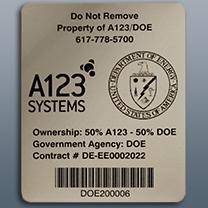The aerospace industry is a highly competitive space and requires companies to focus on streamlining their manufacturing processes for maximum efficiency. With a high priority on quality control and component reliability, there are many opportunities for implementing long-lasting barcodes to ensure accurate asset management. Especially in today’s environment, durable barcode labels and nameplates are found throughout the aerospace industry.
The primary end-users for aerospace equipment are the airline, space exploration, and defense industries. These businesses are governed by extensive regulations that standardize the production, assembly, operation, and upkeep of flight vehicles and aerospace components. In this post, we’ll take a look at some of the best barcode options available to aerospace manufacturers based on durability requirements and other standards and specifications. Properly implementing barcode inventory management systems helps protect the entire aerospace supply chain with a reliable method for tracking these essential assets.

Aerospace manufacturers that are producing parts and equipment for the commercial airline industry must pay particular attention to the regulations defined by the Airlines for America (A4A) trade association. In particular, Spec 2000 has been created to capture specifications related to the entire parts supply chain. The barcode standards are defined in chapter 9 of the regulations, Automated Identification and Data Capture.
The preferred barcode symbologies are Code 39 and Code 128, though Data Matrix codes can also be used for situations when the available space for a barcode on an item is very limited. Additional commercial airline requirements, such as airworthiness certification, may define additional criteria that apply to barcode types and specifications and should be consulted, as well.
Given the complexity of the military equipment supply chain, there are a number of different regulations that aerospace manufacturers must be mindful of. The primary documents of interest for barcode applications are managed by the United States Department of Defense (DoD):
In addition to these US-based regulations, there is also an important extension of the IUID program that is communicated for international use in North America and Europe by the North Atlantic Treaty Organization (NATO). Individual countries may have their own local requirements, but this document helps to align the standards across the member states.
NASA has adopted the MIL-STD-130 and STANAG 2290 standards for their own use, which aligns with the requirements for military and defense end-users listed above. In addition to these regulations, NASA has also instituted their own regulation that applies to Data Matrix barcode identifiers. The document, NASA-STD-6002 Applying Data Matrix Identification Symbols On Aerospace Parts, may have some additional criteria for barcode symbol design that may be useful for reference.

While unique barcode symbologies may vary based on the specific needs of each end-user, there are a number of applications in the aerospace industry where barcodes are used to track individual items. These include:
When selecting a specific barcode label or panel for an application, the choice is often made based on the durability and design requirements. These are some of the most popular categories of barcode labels and durable asset tags used by the aerospace industry:

Aerospace manufacturers must consider a multitude of design requirements when constructing components and equipment for their customers. By reviewing individual requirements and developing consistent asset labeling workflows, it is possible to integrate unique barcode identifiers into their products that are useful across the entire supply chain. As barcodes continue to be prominently used across aerospace and other industries, there are many opportunities to support the creation of system-wide asset management technologies that can boost the performance of the entire industry.
Our sales engineers are experts in automatic asset tracking, tagging and identification,a nd can answer all your questions. Get in touch now.
Lets Talk ›